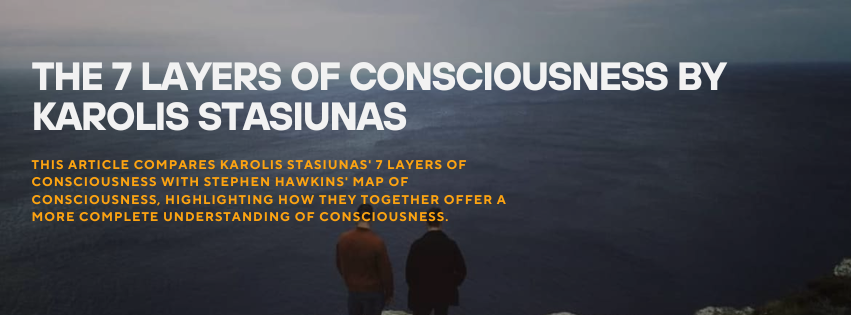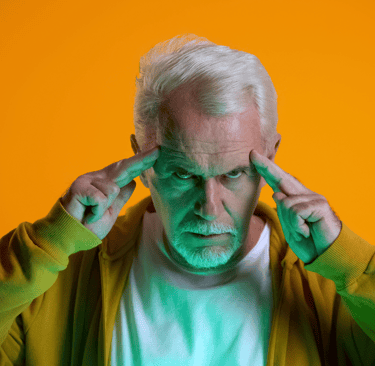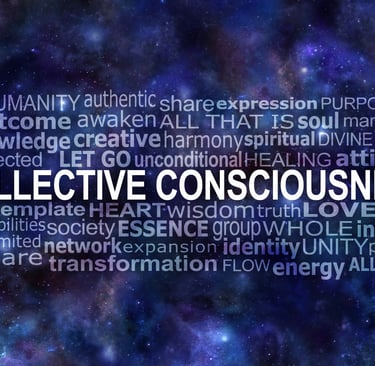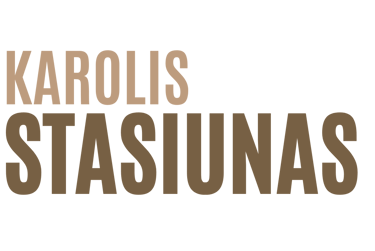
The 7 Layers of Consciousness by Karolis Stasiunas
The study of consciousness has been an enduring fascination in both spiritual and psychological domains. Among the many models that seek to explain the layers and states of consciousness, Karolis Stasiunas’ 7 Layers of Consciousness and Stephen Hawkins' Map of Consciousness stand out for their depth and application. While Hawkins focuses on the ever-changing states of being that individuals can experience, Stasiunas offers a structural framework that explores the different layers of consciousness, where experiences happen, and why. It's like a sprout and a soil. This article provides a brief examination of each layer in Karolis Stasiunas' model, discusses it in comparison with Hawkins' model, and explores how these two frameworks complement each other to offer a more comprehensive understanding of consciousness.
8/22/20247 min read



1. Survival Mind
Description: The Survival Mind is the most primal layer of perceived human consciousness, rooted in basic instincts, our DNR, Ancestors and the whole Biological interconnection. It is concerned with the immediate need for safety, security, and survival. This layer operates largely on autopilot, reacting to perceived threats and ensuring that the organism survives. Its also described in Maslow's Hierarchy As Foundational need of human life.
Example: Consider a person confronted with an immediate physical danger, such as an oncoming car. The Survival Mind triggers an instantaneous response—either to move out of the way or to brace for impact. In a business scenario, this might translate to a company focusing all its resources on avoiding bankruptcy during an economic downturn, prioritising short-term survival over long-term planning.
Comparison to Hawkins: In Hawkins' model, this layer corresponds to lower states of consciousness such as Fear and Guilt, which are characterised by survival-driven behaviour. However, while Hawkins describes these as emotional states that fluctuate, Stasiunas views the Survival Mind as a fundamental layer of consciousness that activates under threat, influencing behaviour and decision-making at a structural level, that is Legs for all other layers of the human consciousness.
2. Collective Unconscious
Description: The Collective Unconscious is the layer where shared memories, archetypes, and symbols reside, influencing behaviour across individuals without their conscious awareness. These are inherited patterns that shape our thoughts, actions, and cultural norms.
Example The "Hero" archetype, deeply rooted in the Collective Unconscious, symbolises courage, determination, and the pursuit of a noble cause. This archetype represents the individual who overcomes challenges, fights for justice, and emerges victorious. In various cultures and stories, the Hero is someone who embarks on a journey, faces adversities, and ultimately brings about positive change.
Business Manifestation: In a corporate setting, the Hero archetype can manifest in multiple ways, companies brand themselves or in the narratives they create around leadership and innovation. For instance, a startup might position its founder as a visionary Hero who defied the odds to create a groundbreaking product. This narrative can inspire employees, attract investors, and build customer loyalty by tapping into the collective admiration for heroic figures who challenge the status quo and drive progress. During hard times everyone can turn to hero when they should turn within while in ‘’good times’’ everyone was looking at heroes they forgot to be heroes themselves, and you don’t want to take away from them their chance to be heroes.
Comparison to Hawkins: While Hawkins’ model doesn’t directly addres the Collective Unconscious, it does acknowledge collectively shared states like Pride and Courage, which can influence group behavior. Stasiunas’ model, however, places a stronger emphasis on the structural role of the Collective Unconscious, explaining how these shared archetypes and patterns influence collective behavior and decisions.
3. Unconscious
Description: The Unconscious layer consists of all the thoughts, memories, and emotions that are not currently in conscious awareness but still influence our behavior. This layer holds repressed memories, unresolved conflicts, and deep-seated fears. Karolis explains that as local emotional imprint, a ‘’data’’ that is unravelled in your conscious awareness. This is the part of consciousness that is responsible for providing navigation to the brain on quick filtering, quick anchoring and it is grounds for copying mechanism and behaviour patterns to form and stay in the loop.
Example: A person who consistently avoids social interactions may be influenced by unconscious memories of past rejections or humiliations. In the business world, unconscious biases might affect hiring decisions or team dynamics, even if the decision-makers are not consciously aware of these biases.
Comparison to Hawkins: In Hawkins' model, lower states like Shame and Guilt often stem from unresolved unconscious issues. Stasiunas, however, identifies the Unconscious as a specific layer that requires conscious exploration and re-learning to move beyond limiting beliefs and behaviours.
4. Sub-Conscious
Description: The Sub-Conscious layer operates just below the level of conscious awareness and governs our automatic behaviors, habits, and conditioned responses. It’s like a vessel between unconscious and conscious.
Example: A habit like checking your phone as soon as you wake up is driven by the Sub-Conscious Process. In the workplace, employees might automatically adhere to established routines or protocols, even if they are no longer the most efficient or relevant.
Comparison to Hawkins: Hawkins suggests that as individuals move up the scale, from Apathy to Willingness, they begin to act more consciously and less from conditioned responses. Stasiunas’ model, however, focuses on the Sub-Conscious as a distinct layer where these automatic behaviors originate and influence our daily lives. Its like a touch of air and water on surface.
5. Conscious
Description: The Conscious layer is where active thought, deliberate decision-making, and intentional actions take place. This is the level of awareness where we are fully present, aware of our surroundings, and in control of our choices to a degree of our awareness on where from and how our local consciousness were formed.
Example: A leader who makes a strategic decision after careful consideration of all factors is operating from the Conscious layer. This is where reasoning, logic, and self-awareness come into play, guiding actions that are aligned with one’s values and goals. Conscious state is always in the Now.
Comparison to Hawkins: This aligns with the higher states in Hawkins’ model, such as Reason and Love, where individuals are more aware, intentional, and aligned with their higher purpose. Both models see the Conscious layer as central to effective leadership and decision-making. Hawkins model is based on states of being, and they can only be experienced with conscious awareness.
6. Collective Conscious
Description: The Collective Conscious layer represents the shared awareness within a group. It reflects a collective identity, purpose, and goals that drive group behavior and decision-making. Cultures, religions, communities, teams.
Example: In a company with a strong corporate culture, the Collective Conscious is what drives employees to work towards a common mission, fostering unity and cohesion. This layer is crucial for building effective teams and ensuring organisational alignment.
Comparison to Hawkins: Hawkins discusses collective emotional states like Joy and Peace, which can resonate across groups. However, Stasiunas emphasizes the structural formation of collective awareness, highlighting how it shapes group dynamics and influences collective outcomes through different state awareness and transformation.
7. Universal Consciousness
Description: Universal Consciousness is the highest layer that is all 7 Layers as one. All is One. Representing a state of unity and oneness with the universe. It is a transcendent state where the individual self merges with the collective whole, experiencing a deep connection with all life.
Example: Individuals who operate at this level often prioritize global or universal goals over personal ones. In business, this might manifest as a focus on sustainability, social responsibility, and ethical practices that benefit the broader community and environment.
Comparison to Hawkins: This corresponds to the highest states in Hawkins’ model, such as Enlightenment, where individuals transcend ego and operate from a place of universal love and understanding. Both models see this as the pinnacle of consciousness, but Stasiunas’ model emphasizes the structural progression to reach this state.
Key Differences Between the Models
1. States vs. Structures
Hawkins: Focuses on states of being that are ever-changing, with individuals moving up or down the scale depending on their emotional and spiritual state.
Stasiunas: Offers a structural framework, where each layer represents a distinct level of consciousness that influences behaviour, decision-making, and experience. Karolis model is a soil on which Hawkins model is explained.
2. Emotional States vs. Levels of Awareness
Hawkins: Primarily deals with emotional states and their impact on consciousness, providing a roadmap for spiritual growth.
Stasiunas: Focuses on depth of awareness, exploring how each layer influences our thoughts, behaviours, and interactions.
3. Practical Application
Hawkins: Useful for personal spiritual development, helping individuals transcend lower states of consciousness to achieve enlightenment.
Stasiunas: Offers a practical framework for understanding and navigating consciousness in everyday life, making it applicable in both personal and organisational contexts.
How Both Models Complement Each Other
Despite their differences, Karolis Stasiunas’ 7 Layers of Consciousness and Stephen Hawkins’ Map of Consciousness complement each other by offering a holistic understanding of consciousness that addresses both structural and emotional aspects.
1. Integration of Emotional and Structural Understanding
By combining Hawkins’ focus on emotional states with Stasiunas’ structural approach, one gains a comprehensive understanding of what they are experiencing, why they are experiencing it, and how to navigate these experiences. This integration fosters more effective personal and professional development.
2. Navigating Consciousness in Different Contexts
Hawkins’ model is powerful for personal spiritual growth, guiding individuals from lower emotional states to higher states of consciousness. Stasiunas’ model, on the other hand, provides a practical framework for applying these higher states in real-world situations, from personal growth to organisational leadership. Karolis model doesn’t define good or bad, high or low. It discusses the origins of the local conscious mind.
3. Co-Creation and Innovation
Both models highlight the importance of co-creation in achieving awareness on your states and origins of consciousness formation within one self. Hawkins suggests that as individuals raise their consciousness, they naturally attract partnerships that align with higher values. Stasiunas emphasises the importance of collective consciousness in terms of emotional entanglement that supports the attraction theory.
4. The Role of Partnership in Consciousness
Both models underscore the significance of partnership in navigating and elevating consciousness. While Hawkins focuses on personal growth leading to more enlightened partnerships, Stasiunas offers a structural perspective on how collective consciousness forms and evolves, highlighting the potential for collaboration and co-creation in achieving shared goals and at the same time making very contraversial statement that All is one and that we are always enlightened, its just our brain that has a conditioning to believe in good, bad, right wrong, higher lower, better worse.
Karolis Stasiunas’ 7 Layers of Consciousness and Stephen Hawkins’ Map of Consciousness offer distinct yet complementary perspectives on the nature of consciousness. While Hawkins focuses on the emotional states that shape our experience, Stasiunas provides a structural framework for understanding the layers of consciousness that underlie these experiences. Together, these models offer a more comprehensive understanding of consciousness, helping individuals and organisations navigate their inner and outer worlds more effectively.
Would you like to work with Karolis Stasiunas On His Personal Advisory? Or Interested to Explore Legacy Partner Benefits? Contact Here.








Contacts
sales@karolisstasiunas.com
Socials


